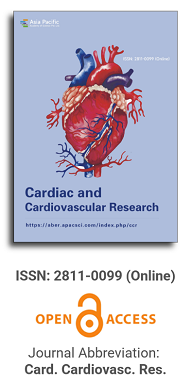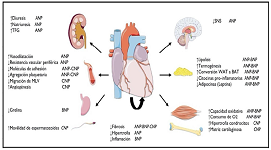
Asia Pacific Academy of Science Pte. Ltd. (APACSCI) specializes in international journal publishing. APACSCI adopts the open access publishing model and provides an important communication bridge for academic groups whose interest fields include engineering, technology, medicine, computer, mathematics, agriculture and forestry, and environment.

This issue examines the multifaceted impacts and clinical challenges of cardiovascular health, highlighting the necessity of considering diverse factors in treatment strategies. This research provides new perspectives for the future of cardiovascular health.
Issue release: 30 June 2023
Objective: To investigate the effect of clopidogrel gene polymorphism on platelet reactivity and major cardiovascular events in patients with acute coronary syndrome (ACS). Methods: 149 patients with ACS who underwent percutaneous coronary intervention (PCI) in Zhongshan Hospital Affiliated to Fudan University from January to December 2019 were included. All patients were tested for clopidogrel related genotypes after admission. Aspirin (100 mg/d) and clopidogrel (75 mg/d) were taken regularly after operation, and the inhibition rate of platelet aggregation (IPA) induced by adenosine diphosphate (ADP) was detected. According to the IPA results, the patients were divided into two groups: high platelet reactivity (HPR) group after clopidogrel treatment (IPA < 30%) and low platelet reactivity (LPR) group after clopidogrel treatment (IPA > 30%). Results: According to IPA results, there were 23 cases (15.44%) in HRP group and 126 cases (84.56%) in LRP group. The IPA induced by arachidonic acid (AA) in HRP group was significantly lower than that in LPR group (p < 005). There were significant differences in CYP2C19*2, CYP2C19*3, ABCB1 AND PON1Q192R loss of function (LOF) alleles between the two groups (p < 005). Multivariate logistic regression analysis showed that CYP2C19*2DF allele was associated with mace after PCI (or = 3112, 95%СI 1048~9241, P = 0.041). Conclusion: Clopidogrel gene polymorphism has certain effect on platelet reactivity in patients with ACS. CYP2C19*2 gene mutation is related to mace after PCI.
Issue release: 30 June 2023
Renal lithiasis (RL) is a common disease whose prevalence has increased in recent years. It is now considered a systemic pathology, not limited to the kidney and urinary tract, but largely related to diabetes mellitus, obesity, arterial hypertension, hyperuricemia, hypercholesterolemia, and chronic kidney disease, all cardiovascular risk factors that are often linked to severe events such as stroke, coronary heart disease, or acute myocardial infarction. Numerous crosssectional studies and meta-analyses have demonstrated the association between these two entities. In this review we will attempt to demonstrate the mechanisms involved in the pathophysiology of RL and its relationship with cardiovascular disease. As mechanisms involved, three associations are mentioned. The first refers to oxidative stress and inflammation. The second association refers to the presence of lithogenic mechanisms that contribute to vascular calcification. The last theory is the already known association of obesity, metabolic syndrome, diabetes and HT, all risk factors for the development of RL as well as cardiovascular disease, remembering that RL is the cause, in 8%, of the development of chronic kidney disease, another risk factor for cardiovascular disease and death. In conclusion, the theory that RL is not a disease limited to the kidney and urinary tract, but a systemic disease, with a risk of cardiovascular events so severe that they can lead to death, is confirmed
Issue release: 30 June 2023
Cardiovascular diseases (CVDs) are cited as the deadliest of illnesses. Their incidence and prevalence around the world are steadily rising. CVDs are the cause of approximately one-third of all deaths in the world. It has been stated in empirical studies over the years that poor socioeconomic status, the lack of social support, stress at work and in the family, depression, and psychosocial risk factors such as anxiety and feelings of hostility aggravate the risk of developing coronary heart disease and also worsen the clinical course and prognosis. Additionally, psychobiological, and behavioral mechanisms have been identified in this context. Psychosocial risk factors should be identified in clinical practice and medical results shared with individuals with CVDs, who should also be screened for anxiety, stress, and stress management, as well as for symptoms of depression. Individuals at risk or who are diagnosed as displaying symptoms of anxiety and depression should be referred to psychiatric professionals to ensure that they receive assistance. Cardiac rehabilitation may involve psychosocial interventions that include cognitive behavioral therapy, problem-solving therapy, and stress management programs, applied on their own or together with other interventions. The aim of this review article is to examine CVDs and community mental health, determine which applications may be adopted as standard practice in this context, and raise awareness about this topic among the public and especially among health professionals.
Issue release: 30 June 2023
Since Egaz Moniz introduced angiography, neurovascular interventions have undergone significant advancements. The integration of advanced biomaterials has refined endovascular devices and techniques for complex vascular lesions. The domain of neurointerventions includes neuroendovascular surgery, endovascular neurosurgery, and interventional neurology. Notably, in regions with limited neurointerventional specialists, interventional cardiologists are increasingly treating cerebrovascular strokes. The congruence between coronary and carotid interventions has facilitated the development of adaptable cerebrovascular tools, many inspired by those in cardiac catheter labs. This article provides an overview of key developments in neurointerventions, with a focus on the adaptation of tools between coronary and cerebrovascular procedures.
Issue release: 30 June 2023
Cardiovascular disease has become the leading cause of death in China. Home medical monitoring of cardiovascular circulatory system (cardiovascular system for short) is of great significance for the early detection, diagnosis and treatment of cardiovascular diseases. Physiological parameters of the cardiovascular system mainly include blood pressure, cardiac output, blood glucose content, blood oxygen saturation, ECG, respiration, etc. These physiological parameters need long-term daily monitoring to find the abnormalities and changes of the system. Therefore, home medical monitoring is necessary. This paper reviews the current situation of home monitoring technology for the main parameters of cardiovascular system in recent years, and prospects its future research trend.
Issue release: 30 June 2023
Routine 12 lead ECG is a basic method for clinical evaluation and diagnosis of various cardiovascular diseases. However, due to its low accuracy of ECG mapping, it is seriously limited in the study of potential electrophysiological mechanism of arrhythmia and mapping of origin matrix. The emerging non-invasive ECG imaging technology (ECGI) can reverse reconstruct the spatio-temporal dynamic information of electrophysiological activities at various locations of the heart, explore the occurrence and development mechanism of various arrhythmias, and accurately locate their origin, effectively make up for the lack of traditional mapping technology, and play a very important role in guiding clinical diagnosis and treatment. In recent years, studies at home and abroad have shown that ECGI plays an important role in the diagnosis and treatment of various cardiovascular diseases, such as arrhythmias and cardiac resynchronization therapy. As a non-invasive method, three-dimensional ECGI is a significant progress in conventional ECG mapping, and its great potential to guide clinical diagnosis and treatment needs to be tapped. This article reviews the progress of clinical application of ECGI.
Issue release: 30 June 2023
Aortopulmonary (AP) window is a conotruncal defect with an incidence of < 1% amongst congenital heart defects. It often occurs in association with other congenital cardiac defects. Coronary artery anomalies in association with the AP window are infrequent. An anomalous right coronary artery (RCA) from the pulmonary artery (ARCAPA) is an extremely rare entity with 0.002% incidence in the general population. To the best of our knowledge, the triad of Tetralogy of Fallot (TOF), ARCAPA and AP window is not yet reported in the literature.

Prof. Prakash Deedwania
University of California,
San Francisco, United States





 Open Access
Open Access